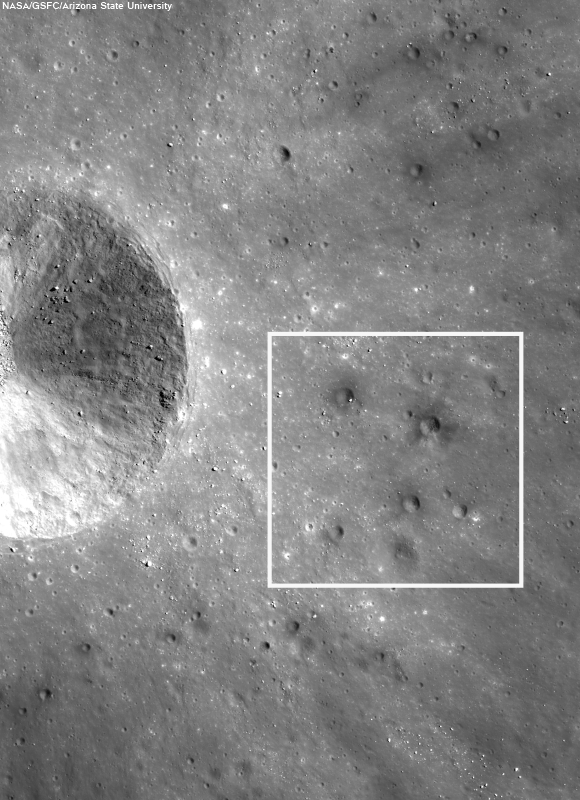 |
| A collection of dark-haloed craters lines a sloping crater rim southwest of Sklodowska crater (19.21°S; 93.56°E). North is up; illumination is from the west-southwest, field of view image is about 625 meters. From LROC Narrow Angle Camera (NAC) observation M174665969R LRO orbit 10974, October 31, 2011; full resolution 0.65 meters from 63.53 km [NASA/GSFC/Arizona State University]. |
James Ashley
LROC News System
The explanation for the origin of dark-haloed craters on the Moon is usually straightforward: Low-reflectivity material (rock or regolith) is overlain by more reflective and more recent deposits (usually ejecta from a relatively fresh impact), and then the underlying deposit is exhumed by even more recent impacts.
This stratigraphy tends to present the darker material as ejecta overlying the lighter material in high contrast. Such is the case for the dark-haloed craters in today's Featured Image.Zooming out to the context frame below reveals their relationship to the crater responsible for the light ejecta.
But why do we see such a high number of these features here, and why do they seem to be grouped close to the rim of this small, unnamed crater located outside Sklodowska crater?
The similarity in ejecta albedo suggests that the time between individual crater impacts was not great, and they are therefore likely to be secondary craters having a single larger impact as their source. The main question is whether the bolides that formed this group of craters arrived from an impact some distance away, or whether they are examples of so-called "self-secondaries." In the latter case, the blocks that created these features would have been ejected almost vertically during excavation of the large crater in the context image. They would have remained aloft long enough for the main ejecta blanket to be emplaced before returning to the surface and creating the pattern we see. Some recent studies are suggesting that more self-secondary craters are to be found closer to the main crater rim. This new finding can explain why there appear to be more of these dark-halo craters closer to the main crater rim, if they are indeed self-secondaries.
If, however, these secondary impacts originate with another, more-distant impact, then the clustering we think we see may be illusory. Perhaps this apparent grouping depends more on the location of the low-reflectance deposits than on the locations of the impacts. In that case many other craters in the region might also be related by formation time to these dark-haloed craters, but do not show dark haloes because they missed those deposits.
The WAC mosaic reveals the broader context of the Featured location. What other craters can you find in this area that might be responsible for the secondary impacts? Why or why not? Which theory seems to have the most validity? Can you think of other scenarios that could account for today's Featured Image?
Click HERE to review the full NAC image. Additional examples of secondary features can be found in The Rays of Messier A, the Chain of Secondaries in Mare Orientale, and in Scouring Secondary Ejecta.
LROC News System
The explanation for the origin of dark-haloed craters on the Moon is usually straightforward: Low-reflectivity material (rock or regolith) is overlain by more reflective and more recent deposits (usually ejecta from a relatively fresh impact), and then the underlying deposit is exhumed by even more recent impacts.
This stratigraphy tends to present the darker material as ejecta overlying the lighter material in high contrast. Such is the case for the dark-haloed craters in today's Featured Image.Zooming out to the context frame below reveals their relationship to the crater responsible for the light ejecta.
But why do we see such a high number of these features here, and why do they seem to be grouped close to the rim of this small, unnamed crater located outside Sklodowska crater?
 |
| The wider NAC frame around the field of view selected for the LROC Featured Image (white square) in broader context. Field of view ~2.7 km [NASA/GSFC/Arizona State University]. |
If, however, these secondary impacts originate with another, more-distant impact, then the clustering we think we see may be illusory. Perhaps this apparent grouping depends more on the location of the low-reflectance deposits than on the locations of the impacts. In that case many other craters in the region might also be related by formation time to these dark-haloed craters, but do not show dark haloes because they missed those deposits.
 |
| The WAC mosaic context image shows few bright-rayed craters in the region; field of view 144 km, north is up [NASA/GSFC/Arizona State University]. |
Click HERE to review the full NAC image. Additional examples of secondary features can be found in The Rays of Messier A, the Chain of Secondaries in Mare Orientale, and in Scouring Secondary Ejecta.




No comments:
Post a Comment